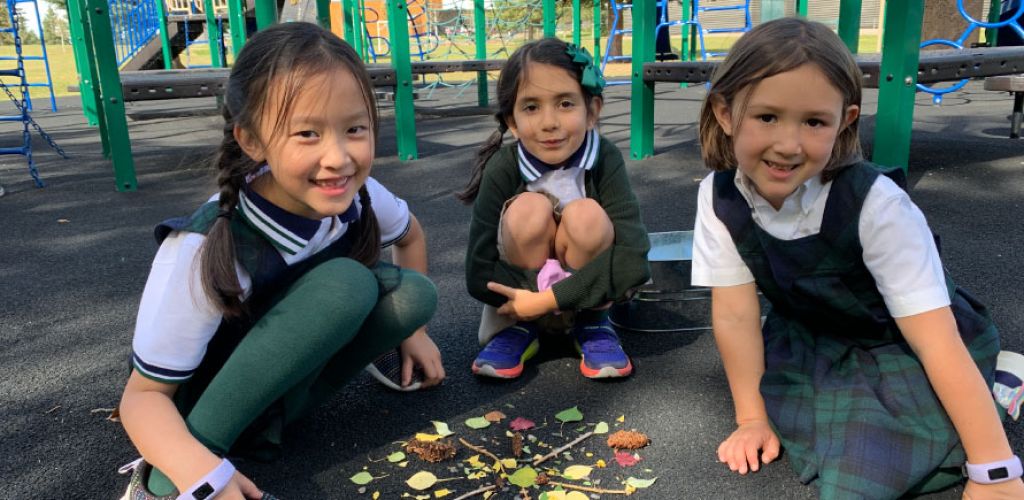
Exploring the World Beyond the Classroom
By: Laura Boudens, Elementary Physical Education and Experimental Education Learning Leader
NOT ONLY DOES OUTDOOR SCHOOL HELP TO INSPIRE AN APPRECIATION FOR NATURE, IT ALSO EMPOWERS EACH CHILD TO DETERMINE WHAT PERSONALLY MOTIVATES THEM TO GET OUTSIDE, CONTRIBUTING TO THEIR OVERALL WELL-BEING.
The outdoors are experiential in nature. Just as every living organism grows in relation to its environment, the same is true of a child exploring the world beyond their classroom. The more our students and teachers learn about the outdoors, the more we all realize just how many vital lessons the beautiful and diverse landscape of the Strathcona- Tweedsmuir School (STS) campus has to offer.
When COVID-19 created restrictions as to when, where, and how our outdoor schools could proceed, we took a moment to reflect both on those options immediately available to us and what outdoor experiential learning really means to our students. Rather than seek a camp in the distance, we chose the path less traveled — and found a new appreciation for the wilderness right on our doorstep. Students in all Elementary School grades had the incredible opportunity to learn outside as part of “outdoor school”.
Outdoor school is about building a connection: to nature, to our studies, to each other, and to ourselves. From science to literacy to art, our outdoor activities are designed to complement what is learned in the classroom, and they provide a safe environment in which students can exercise their bodies, brains, and inquisitive spirit. Not only does outdoor school help to inspire an appreciation for nature, it also empowers each child to determine what personally motivates them to get outside.
Do they enjoy being outdoors with social interaction? Are they visual learners? Perhaps they prefer solitude? Is it the challenge of reaching the summit that drives them, or the promise of the view they’ll enjoy at the top?
The Grade 6 unit on Trees and Forests presented a perfect opportunity for students to discover a link between the words and images in their textbooks and the realities of the natural world. With input and guidance from Parks Canada and the Palisades Centre in Jasper, students were each given an aluminum tray in which they built a matchstick forest. Based on the density and positioning of their ‘trees’, the wind, and the contours of their constructed landscape, children were able to observe and analyze the outcome of a simulated lightning strike or human-caused fire on their plot of land. Questions are encouraged in every situation: ‘What sorts of things can we use wood for? Could deforestation become an issue? How do you feel about that?’
Reflection remains a core tenet of outdoor experiential learning. This year, in the spirit of reconciliation, we asked our Grade 4 students to describe those things that they feel best represent Canada. Hockey was immediately brought up, which allowed us to reflect on the First Nations origins of our national sport, as well as how Indigenous traditions and culture have helped shape our national identity as a whole. STS has been working to build meaningful connections with First Nations and Metis in our area, and we were most fortunate to have the opportunity to gain a new historical perspective from local Elders and Knowledge Keepers, who taught us the importance of official land acknowledgments and why our school includes them in our activities.
Out of reflection comes appreciation, and our students have had many opportunities to learn what it truly means to be stewards of the land. The planet on which we live is a gift; one that we must preserve and protect for future generations, much as First Nations did for millennia before our arrival to this continent. To further illustrate this lesson, we created a visual timeline along Buchan Boulevard with a scale of 50 years to every step. Students were amazed that the oldest evidence of Indigenous peoples in Canada stretched the length of the field, while European settlers and their descendants occupied only the last ten steps. It was an eye-opening experience for all.
One of my favourite aspects of outdoor school is that it gives each child a chance to learn from and adapt to their surroundings at their own pace, especially as part of a nature solo. Students take their clipboards and find a quiet spot from which they can observe and ponder the world around them. Some choose to write, others to draw. Dandelion petals and mud from a rock are shaped into quill and ink when a pencil is forgotten in the classroom. It serves as one more reminder that nature has countless lessons to share — we just have to learn how to see and hear its wisdom.